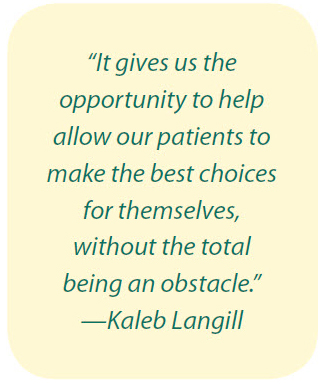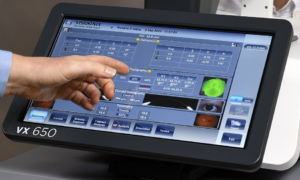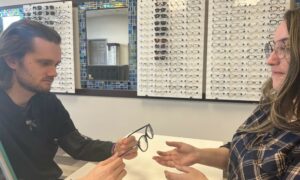Sponsored Content

By ROB Editors & Kaleb Langill
When patients accept the full treatment plan, they benefit, and so does your practice. The challenge is getting them to do that.
Before you even ask yourself whether the majority of your patients are opting in to the full treatment plan that you give, take a moment to reflect: are you actually providing a full treatment plan?
Patients expect that they will receive from your office all the advice they need on their eyecare and eyewear. But are they getting it? Some doctors or their staff members may pull back from providing a full treatment plan for various reasons.
- Worry about the cost to the patient
- Concern about giving the patient “too much” information
- Unease about creating the perception that they’re “overselling” patients
It’s important to make sure everyone in the office is on board with doing everything possible to get patients to accept the full treatment plan–including the doctor. You may be undermining your own efforts without even realizing it.
Prioritizing the Treatment Plan
Doctors can present their full treatment plan with priority items noted, whether that’s for the options in a dry eye treatment protocol or for eyewear choices, indicating what is of most immediate concern. Then identify what the next priority should be. For example, the doctor might say: “You said you’ll be starting a new job next month. For those commutes, a pair of prescription sunwear with antiglare lenses will make your drive much more comfortable.”
It Makes You Look Good When Patients Have a Way of Getting All You Prescribe
When the optometrists provide patients with a treatment plan, it’s often for more than one item. It can include contact lenses plus backup eyewear, specialized multiple pairs, dry eye treatment or vision therapy, for example. The point is that the costs of fulfilling these recommendations can add up. So patients appreciate being able to use their CareCredit card to purchase what they need right away—without having to make the difficult cost choices of what they can do without, says Kaleb Langill, the business manager for The VisionCenter of West Texas in Lubbock, Texas.
Cardholders can combine special financing with any in-office offers, such as for second pairs or a reduced price on nonprescription sunwear with an annual supply of contact lenses.
Langill calls the CareCredit credit card “one of the services that makes us look good.” What he means is that by accepting CareCredit, the office can help make sure that patients who use the card with its special financing options are often able to get the full range of treatment options that the doctors recommend. The practice looks good because it helps patients overcome reluctance or use smart money strategies to buy what they need.
The CareCredit credit card is a trusted form of patient financing, and the only one that Langill says his practice offers. “CareCredit is the only patient financing health care credit card we accept,” he says. “It has the best versatility because it can be used in other health care providers’ offices, and the special financing is very attractive.”
“It gives us the opportunity to help allow our patients to make the best choices for themselves, without the total being an obstacle. Our doctors are recommending medical devices or services that will help the patient. It’s not like it’s another pair of shoes or consumer luxury. These are necessities,” Langill says.
CareCredit is well-known in the area. “A lot of patients bring it up to us even before we have the opportunity to address it. Some have found us on the CareCredit acceptance locator, and they chose this practice in part because they can use that financing here. Or some see the signage and realize that they can be less concerned about how much today’s visit and products will cost because they can use their CareCredit card,” he says.
Recommending Second Pairs
Patients purchasing second pairs of eyewear is becoming more common, Langill says. “The doctors typically prescribe more than one pair, noting that a second pair could be for computer distance but would also work well for cooking dinner or anytime that they’re looking at that distance. In the optical, to uncover the patients’ needs, too.”
 The simplest way to do that, he says, is to encourage patients to tell the opticians about how they use their eyeglasses and then ask, “What can be improved?” The answers are revealing because patients will often articulate some of what they heard in the exam room. Maybe they feel eye strain after a whole day at the computer, or maybe the sunlight bothers them on their drives to and from work. Letting patients identify the shortcomings in their current experiences helps set the foundation for why multiple pairs of eyewear make sense.
The simplest way to do that, he says, is to encourage patients to tell the opticians about how they use their eyeglasses and then ask, “What can be improved?” The answers are revealing because patients will often articulate some of what they heard in the exam room. Maybe they feel eye strain after a whole day at the computer, or maybe the sunlight bothers them on their drives to and from work. Letting patients identify the shortcomings in their current experiences helps set the foundation for why multiple pairs of eyewear make sense.
Making It Easy
Although many patients already know about CareCredit as a payment option, those who don’t are told how convenient it is. “We’ve had patients who go sit in our lobby, apply on their phones at the CareCredit website and come back to the front desk with an account number,” Langill says. The practice has opened a second location, where the experience is more “digitally integrated.” iPads are used for check-ins, which allow patients to apply for CareCredit even before starting their exam.
“We don’t want patients to have to make compromises, either by deciding to delay a purchase or by trying to find a less expensive and less reliable online alternative,” he says. “The practice staff tells patients that the practice stands behind any products it dispenses, a promise that online retailers may not always be able to make. We find that the prices at the practice are higher than these online sellers because the quality is better.” He tells patients, “We want to protect your purchase, so the way to do that is to sell you high-quality materials.”
He also emphasizes the importance of letting eligible patients know that any products or services from the office can be paid for with their CareCredit credit cards. “When we sit down with the patient, we can say, ‘Here’s everything that the doctor recommended for you. Whatever your health/ vision insurance doesn’t cover can be put on your CareCredit card today, as long as you have credit available.’ The more we can make it manageable for patients, the fewer walls there are between them and the products and services they need and want.”
When you have a reliable resource, like the CareCredit credit card, that makes it more likely patients will accept the full treatment plan, there is no need for any other patient financing tool in the practice. Our patients have all they need to have access to what our doctors prescribed to improve their lives.



























